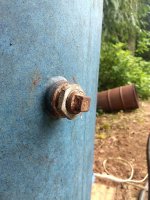One would be in the pump or installed right above the pump. If there is one in the pump, some will install a check valve right above the pump redundancy.Back to the check valve...is there any chance that the pump doesn't have one and that is why there is one up by the tank? I'm guessing they've been putting them on all pumps for decades, at least?
It is possible for that bleeder to be there and not seal.
If you have a bad check valve at the pump or a bleeder that bleeds or a hole in your pipe from the well leaking into the yard, without the topside check valve the pipe will cycle.
There are those who think that a routine topside check valve is a good idea, but it is a minority opinion. There is even currently at least one state that requires such a top side check valve with a submersible pump. Some states say if you have one, you need a vacuum breaker to prevent a vacuum from sucking in yard water. Many states prohibit. I started making a list, but I did not get far. I found nothing for PA. You might search back into the older posts of the forum, and get more discussion on the topic. I find the reasons for not having one compelling.
It is often possible to remove the innards of a check valve for easier restoration later. I have not seen anybody do it, but it would be possible to bypass a check valve with a ball valve for experiment or workaround for a leak later that would be fixed the next time the pump were pulled.
Note that your test of closing the valve to the house while the pressure tank is pressurized is an easy quick test if there is any lingering doubt. You can also close that valve while doing your work at the tank to not have to drain the house pipes.

